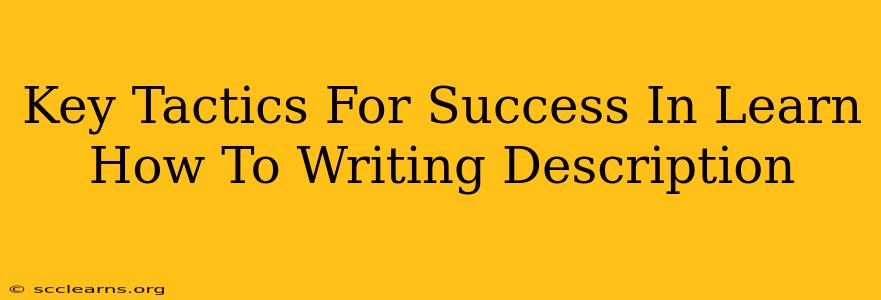Writing compelling product descriptions is crucial for online success. They're not just about listing features; they're about painting a picture, telling a story, and ultimately, driving sales. This guide outlines key tactics to master the art of product description writing.
Understanding Your Audience: The Foundation of Great Descriptions
Before you write a single word, understand who you're writing for. Consider these questions:
- What are their needs and pain points? Your description should address these directly.
- What's their level of technical expertise? Avoid jargon if your audience isn't technically savvy.
- What's their preferred communication style? Are they formal or informal?
Knowing your audience allows you to tailor your language and tone for maximum impact.
Keyword Research: Getting Found in Search Engines
Effective SEO is paramount. Thorough keyword research is essential to ensure your product descriptions rank highly in search engine results pages (SERPs). Use tools like Google Keyword Planner, Ahrefs, or SEMrush to identify relevant keywords with high search volume and low competition. Naturally integrate these keywords throughout your descriptions, avoiding keyword stuffing.
High-Impact Keyword Integration Strategies
- Focus on long-tail keywords: These are longer, more specific phrases (e.g., "best ergonomic office chair for back pain"). They often attract more qualified leads.
- Use keywords in titles and headings: This signals to search engines the main topic of your description.
- Naturally incorporate keywords in the body text: Don't force keywords; weave them into the narrative organically.
Crafting Compelling Copy: Show, Don't Just Tell
Forget dry, technical specifications. Instead, focus on showcasing the benefits of your product. Use vivid language to create an engaging experience for the reader.
Techniques for Compelling Copywriting
- Highlight key features and benefits: Clearly explain what your product does and how it improves the customer's life.
- Use strong verbs and active voice: This makes your writing more dynamic and engaging.
- Tell a story: Connect with your audience on an emotional level by weaving a narrative around your product.
- Include customer testimonials: Social proof builds trust and credibility.
- Use high-quality images and videos: Visuals enhance the overall shopping experience.
Optimizing for Readability and Engagement
Your descriptions should be easy to read and understand. Use short paragraphs, bullet points, and subheadings to break up the text and improve readability. Consider using formatting techniques to highlight important information.
Boosting Readability and Engagement
- Use clear and concise language: Avoid jargon and technical terms your audience may not understand.
- Write in a conversational tone: Make your descriptions sound natural and approachable.
- Break up long blocks of text: Use headings, subheadings, bullet points, and white space to improve readability.
- Include a clear call to action: Tell readers what you want them to do (e.g., "Add to cart," "Learn more").
Analyzing and Refining Your Descriptions: The Iterative Process
Writing effective product descriptions is an ongoing process. Regularly analyze your results to identify what's working and what's not. Use analytics tools to track key metrics like conversion rates and bounce rates. A/B test different versions of your descriptions to see which performs best. Continuously refine your approach based on data and feedback.
By following these key tactics, you can significantly improve your product descriptions, driving more engagement, conversions, and ultimately, boosting your business's bottom line. Remember, the goal isn't just to inform; it's to persuade and inspire.

